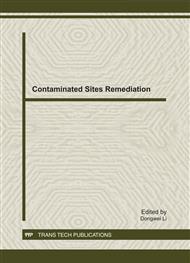p.221
p.226
p.232
p.238
p.244
p.250
p.254
p.262
p.268
Investigation of Contaminated Soils and Plants by Mn in Manganese Mining Area in Xiushan Autonomous County of Chongqing
Abstract:
The manganese contents of soils and dominant plants from the manganese mining areas in Xiushan autonomous county of Chongqing were researched in this paper. The results showed that the Mn pollution of soil in the Mn mining tailings were very serious with high indexes (Igeo>5), and sewage irrigated soil was also contaminated by manganese metal. The uptake of Mn by dominant plants can be classified into three types according to the Mn contents in plant shoots and roots, (1) the accumulator which absorbs a large content of Mn by the roots and transports it to the shoots, (2) the root compartment which also absorbs a large content of Mn but mainly in the roots, and (3) the excluder which absorbs a smaller content of Mn than the accumulator. The edible parts of radishes and peppers growing in the Mn mining tailings and cropland were all seriously polluted by manganese and not safe for human health.
Info:
Periodical:
Pages:
244-249
Citation:
Online since:
December 2011
Authors:
Keywords:
Price:
Сopyright:
© 2012 Trans Tech Publications Ltd. All Rights Reserved
Share:
Citation:


